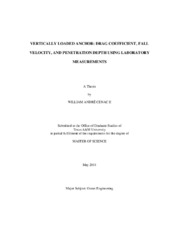| dc.description.abstract | The offshore oilfield industry is continuously developing unique and break-through technologies and systems to extract hydrocarbons from ever increasing ocean depths. Due to the extreme depths being explored presently, large anchors are being utilized to secure temporary and permanent facilities over their respective drilling/production site. A vertically loaded, torpedo-style, deepwater mooring anchor developed by Delmar Systems, Inc. is one of these anchors. The OMNI-Max anchor is an efficient, cost-effective alternative for use as a mooring system anchor intended for floating facilities. The OMNI-Max is designed to free-fall towards the ocean bottom and uses its kinetic energy for self-embedment into the soil, providing a mooring system anchor point. Values such as drag coefficient and terminal velocity are vital in predicting embedment depth to obtain the mooring capacity required by the floating facility.
Two scaled models of the Mark I OMNI-Max anchor were subjected to a series of tests in the Haynes Coastal Engineering Laboratory at Texas A & M University to evaluate the overall drag coefficient and penetration depth. The 1/24 scale model was tested by measuring the amount of penetration into an artificial mud mixture. The 1/15 scale model was attached to a tow carriage and towed through a water-filled tank to measure the drag forces and evaluate the drag coefficient. The anchor terminal velocity was measured using underwater cameras to track the free fall of the model anchor through 15 ft of water inside the tow tank.
The 1/24 scale model penetrated the mud an average of 22 inches from the leading tip of the anchor to the mud surface, approximately 1.5 anchor lengths. The penetration depth increased as impact velocity increased, while the penetration depth decreased as the fins were retracted. The 1/15 scale anchor was towed at 6 different velocities producing a varied total drag coefficient between 0.70 and 1.12 for Reynolds number flows between 3.08E 05 and 1.17E 06. The drag coefficient increased as the fins were retracted and when the mooring rope was attached. The 1/15 scale anchor was allowed to free-fall in the tow tank and obtained an average terminal velocity of and 14.6 feet per second. The drag coefficients ranged from 0.46 to 0.83, which increased as the fins were retracted. When using the results to estimate prototype sized anchor drag coefficient, the average value was estimated to be 0.75. | en |


